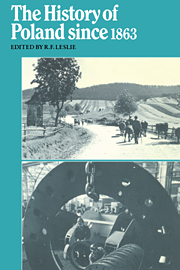Book contents
- Frontmatter
- Contents
- List of maps
- Preface to the paperback edition
- Abbreviations
- Map 1 Poland in the nineteenth century
- 1 Triloyalism and the national revival
- 2 Poland and the crisis of 1900–7
- 3 Poland on the eve of the First World War
- 4 The emergence of an independent Polish state
- 5 The breakdown of parliamentary government
- 6 Piłsudski in power, 1926–35
- 7 Poland without Piłsudski
- 8 Poland in defeat, September 1939–July 1941
- 9 The ill-fated alliance, August 1941–April 1943
- 10 The years of Tempest, May 1943–December 1944
- 11 Post-war Poland
- 12 The rise and ebb of stalinism
- 13 The October turning point
- 14 ‘The little stabilization’
- 15 The decline of Gomułka
- 16 Poland under Gierek
- 17 Polish society, 1945–75
- Epilogue: The rise and fall of Solidarity
- Notes
- Select bibliography
- Index
2 - Poland and the crisis of 1900–7
Published online by Cambridge University Press: 26 December 2009
- Frontmatter
- Contents
- List of maps
- Preface to the paperback edition
- Abbreviations
- Map 1 Poland in the nineteenth century
- 1 Triloyalism and the national revival
- 2 Poland and the crisis of 1900–7
- 3 Poland on the eve of the First World War
- 4 The emergence of an independent Polish state
- 5 The breakdown of parliamentary government
- 6 Piłsudski in power, 1926–35
- 7 Poland without Piłsudski
- 8 Poland in defeat, September 1939–July 1941
- 9 The ill-fated alliance, August 1941–April 1943
- 10 The years of Tempest, May 1943–December 1944
- 11 Post-war Poland
- 12 The rise and ebb of stalinism
- 13 The October turning point
- 14 ‘The little stabilization’
- 15 The decline of Gomułka
- 16 Poland under Gierek
- 17 Polish society, 1945–75
- Epilogue: The rise and fall of Solidarity
- Notes
- Select bibliography
- Index
Summary
The Polish Question did not exist in 1900, but the Great Powers were gradually edging themselves towards an international crisis which would bring it into existence along with other seemingly dormant problems even older than the problem of Poland. Already in 1891 the beginning of the construction of the Trans-Siberian Railway gave notice that tsarist Russia intended within the foreseeable future to become in fact as well as in theory a great power in the Pacific and no longer acquiesce in a position of inferiority. The Sino-Japanese War of 1894–5 resulted from Japan's determination to anticipate the advance of Russia's real power in the Far East. The German initiative which led to the modification of the Treaty of Shimonoseki in 1895 was a precursor of an interest which became actual in 1897 with the German seizure of Kiaochow. The tentative commitment of tsarist Russia to a forward foreign policy by the seizure of Port Arthur in 1897 and the occupation of Manchuria in October 1900 were followed by a long debate upon the real aims of Russian policy. The Weltpolitik pursued by imperial Germany was hardly likely to bring in its train economic and political disasters, but in Russia the Ministry of Internal Affairs was conscious that a policy which put pressure upon the population of the European provinces might cause political upsets likely to call into question the entire system of autocratic government, while the Ministry of Finance knew well that Russia was too weak to sustain an ambitious programme of expansion so far away from the developed areas.
- Type
- Chapter
- Information
- The History of Poland Since 1863 , pp. 65 - 96Publisher: Cambridge University PressPrint publication year: 1980



